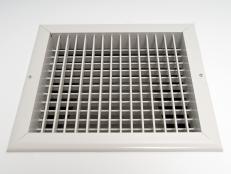Passive Ventilation
Homes today are built to be airtight and energy-efficient, but many consequently suffer from poor indoor air quality, and ventilation is crucial to maintaining healthy air. Indoor air becomes polluted with allergens from pets, odors and humidity from bathroom and kitchen use, and the off-gassing of volatile organic compounds from carpeting and furniture. Ventilation removes polluted, humid indoor air and replaces it with fresher, often less-humid outdoor air.
Two options for removing polluted air and introducing fresh air are mechanical ventilation and passive ventilation. Most often, mechanical ventilation is used exclusively. It includes exhaust fans in kitchens, baths, laundry rooms and attics required by many local building codes. The healthier alternative is to use passive ventilation in conjunction with mechanical ventilation.
What Is Passive Ventilation?
Passive ventilation systems use a series of vents in exterior walls or at exterior windows to allow outdoor air to enter the home in a controlled way. Natural airflow, wind and the temperature differences in indoor and outdoor air help to draw in fresh air and circulate it through the home. The fresh air forces polluted, humid, warmer air into vertical ducts (aka thermal chimneys) that lead into the attic, where the air is exhausted to the outside. The fresh-air vents are specially designed to slow down incoming air and disperse it indoors. An adjustable precision damper within the vent allows the regulation of airflow, and vents are typically equipped with a filter to screen out dust and insects. Some fresh-air vents also have acoustical features for masking outdoor noises from sources such as traffic, airplanes and trains.
Benefits and Drawbacks
Passive ventilation doesn't require electricity, so it saves energy and cuts down on carbon monoxide emissions. It's quiet, inexpensive, energy-efficient and low-maintenance because it requires no moving parts and has no operating costs. After installation, the only maintenance needed is periodical cleaning of the filters.
The biggest drawback of a passive ventilation system is that it's extremely dependent on the outdoor temperature; it functions best during colder periods of the year, when the difference between inside and outside temperatures is greatest. Also, passive ventilation used alone can’t extract humidity from bathrooms and laundry rooms. And passive ventilation systems should be used in conjunction with a heat-recovery unit.
Locating Vents
Fresh-air vents should be located in areas of the home that tend to have cleaner air—bedrooms, living rooms and offices. Never install a fresh-air vent in kitchens or bathrooms or near wet areas of the home. These wet areas of the home should instead be the location for exhaust vents, where polluted air is more likely to be found.
When calculating the number of fresh-air vents needed for a home, consider all livable space as a single unit. First check the manufacturer's specifications to understand how many square feet a particular vent can service. Then calculate the size of the overall living area and determine how many vents to install. For example, if using a vent capable of servicing 100 square feet, use 20 vents to service 2,000 square feet of living space.
In addition to introducing fresh air, air must be allowed to circulate freely among rooms to get maximum performance from a passive ventilation system. To promote good air circulation, be sure to install circulation air vents in internal doors and ventilate the thresholds. Facilitate air circulation at internal walls by installing circulation air ducts. In bathrooms, locate the ducts as low as possible on the walls to allow drier, fresher air to enter and push more humid air to the top of the room and into thermal chimneys. Locate ducts as high as possible in bedrooms and other rooms where the air tends to be cleaner and drier.






































